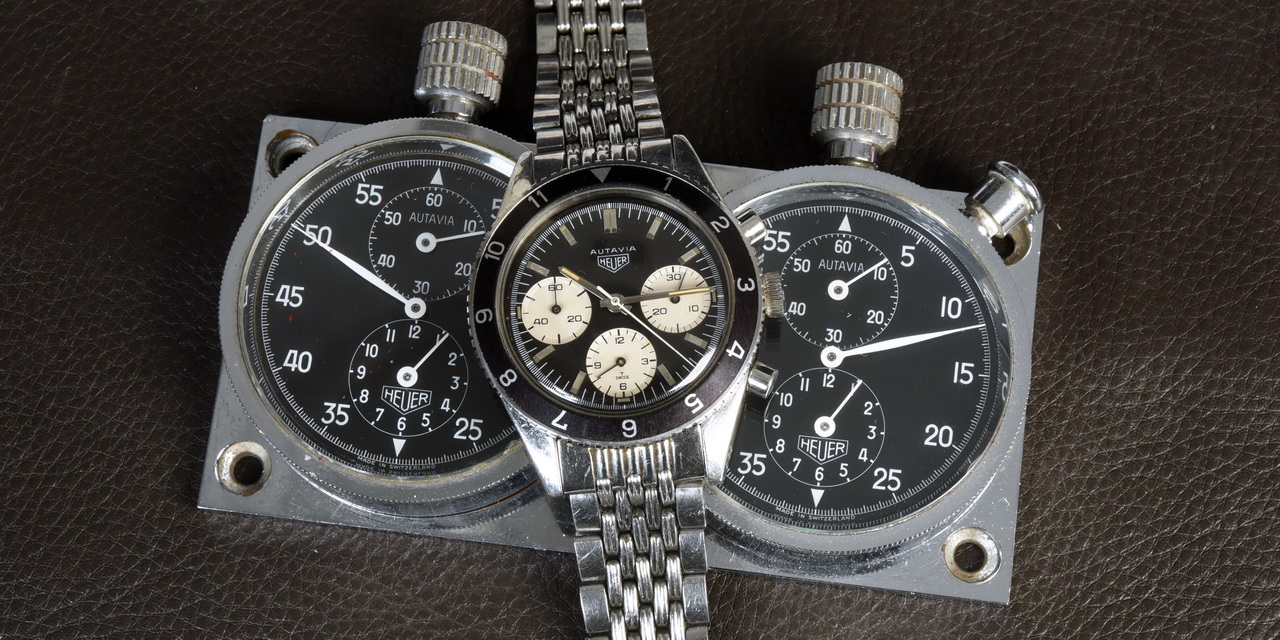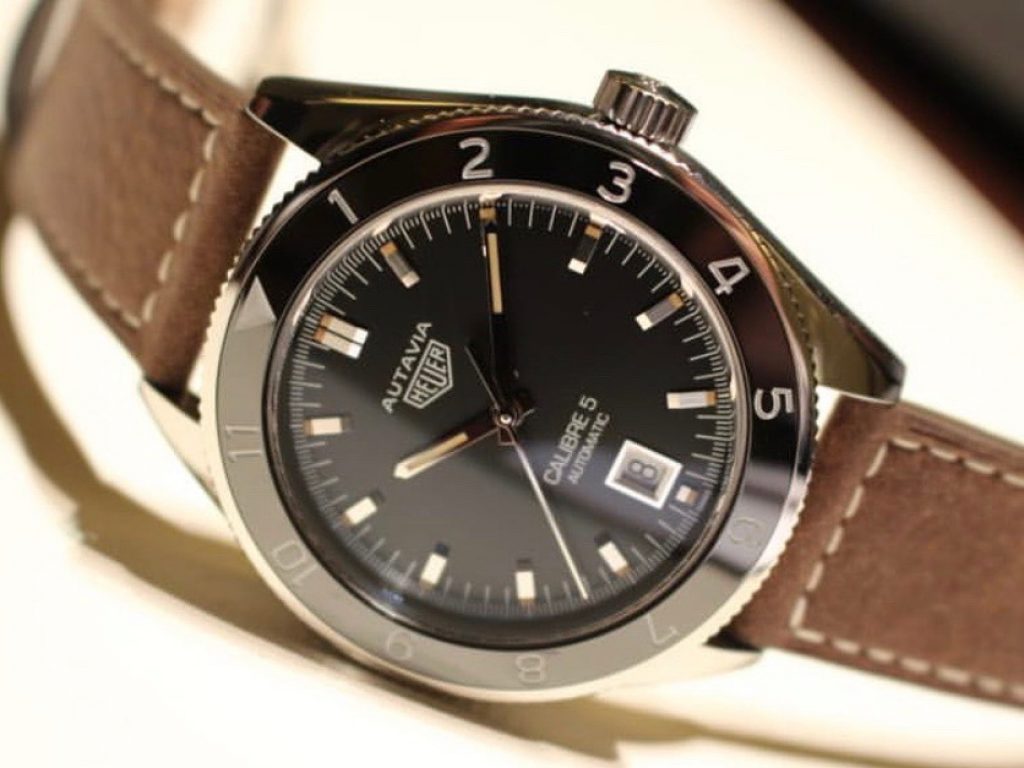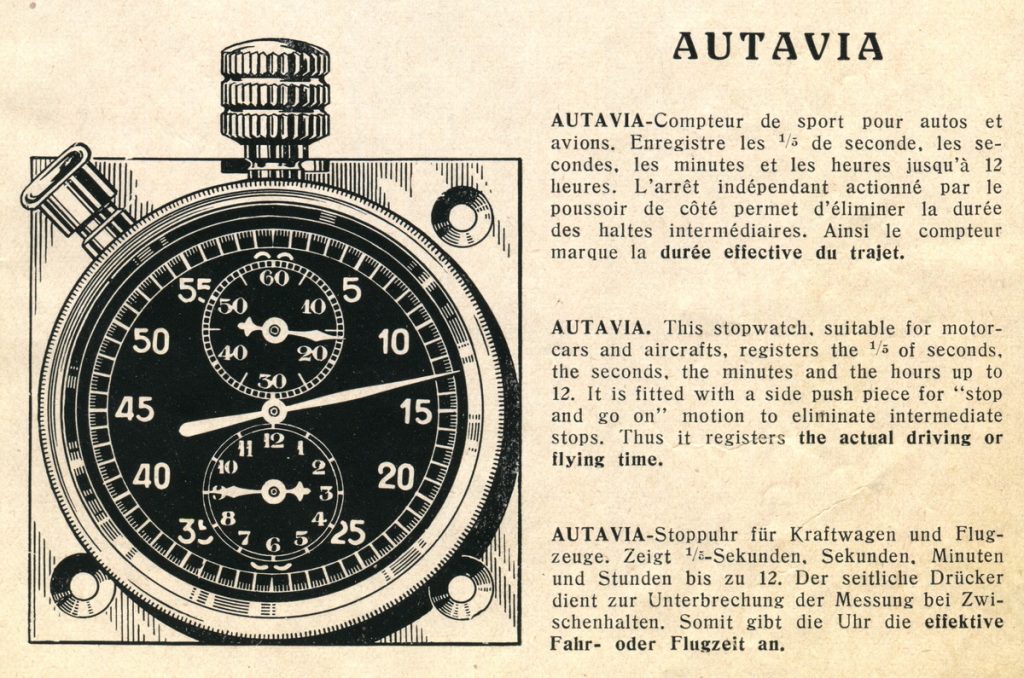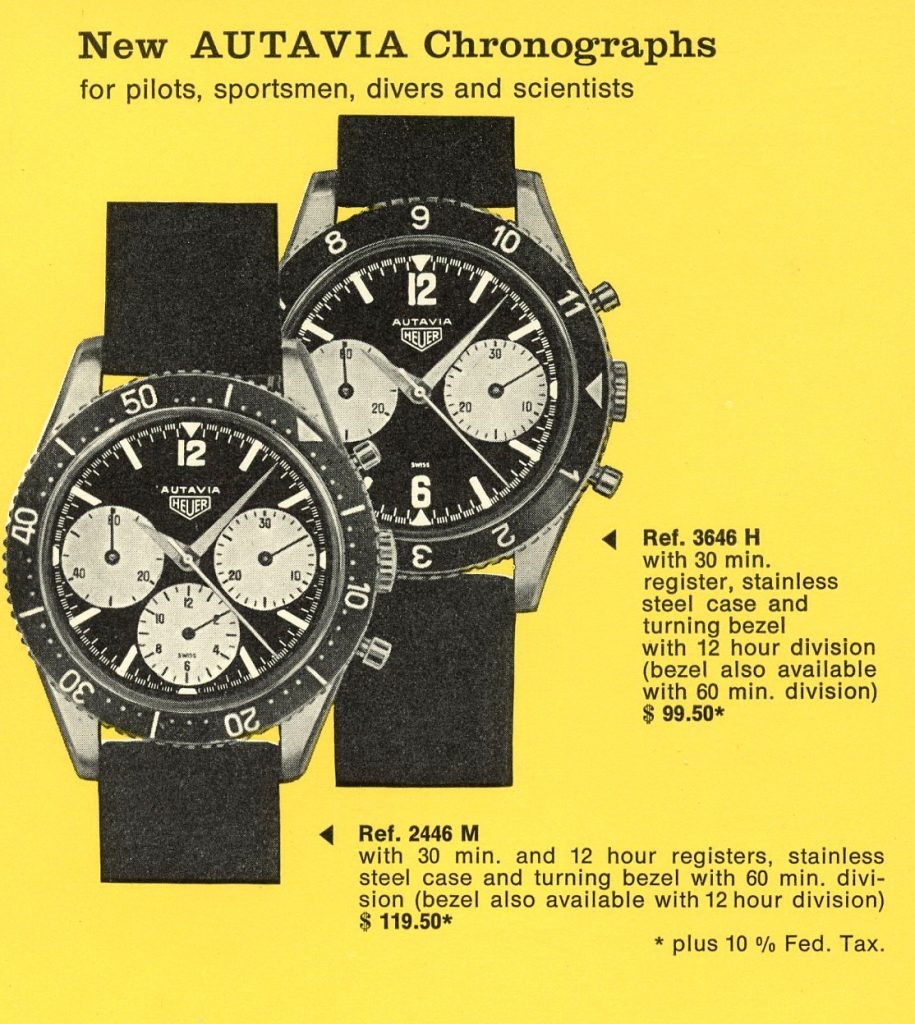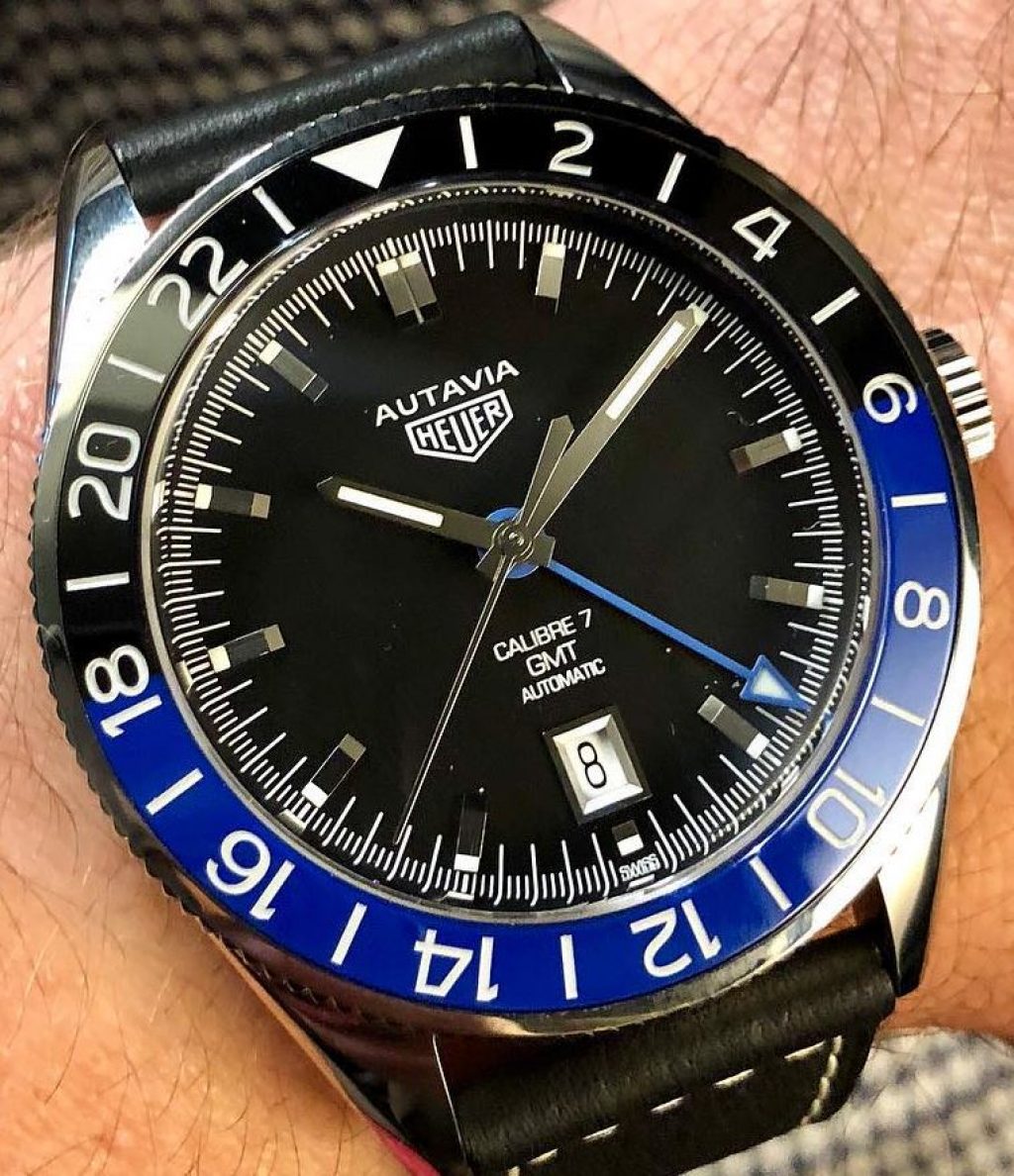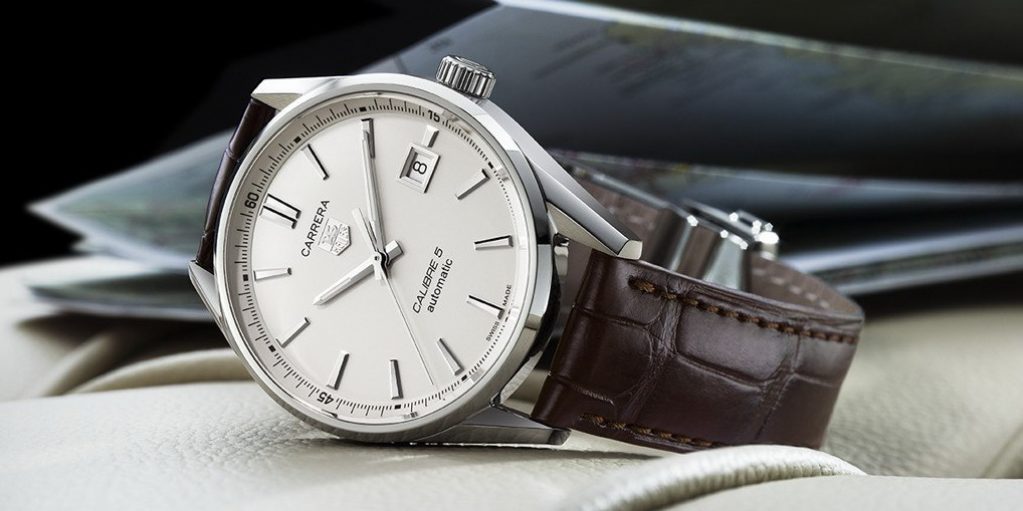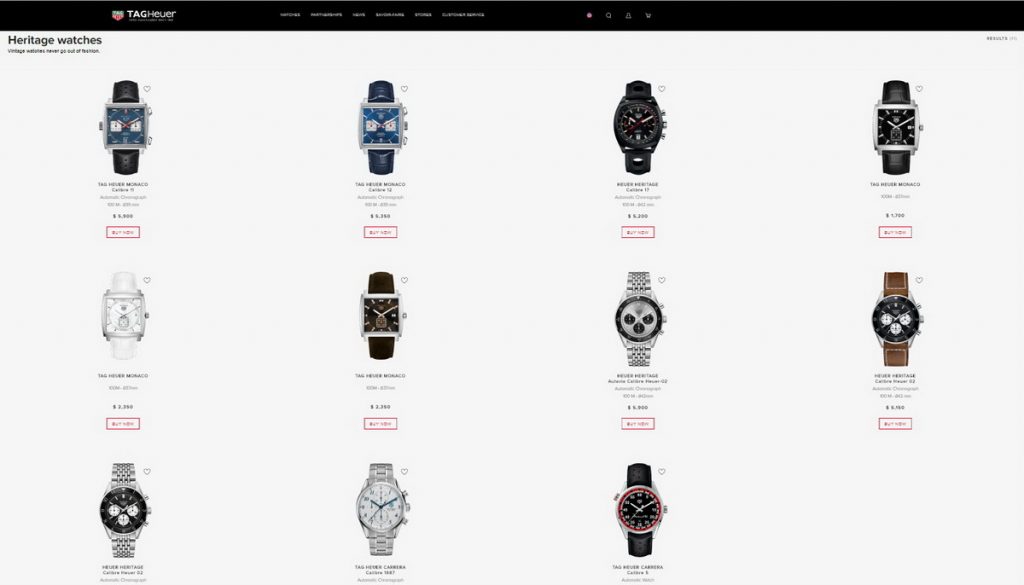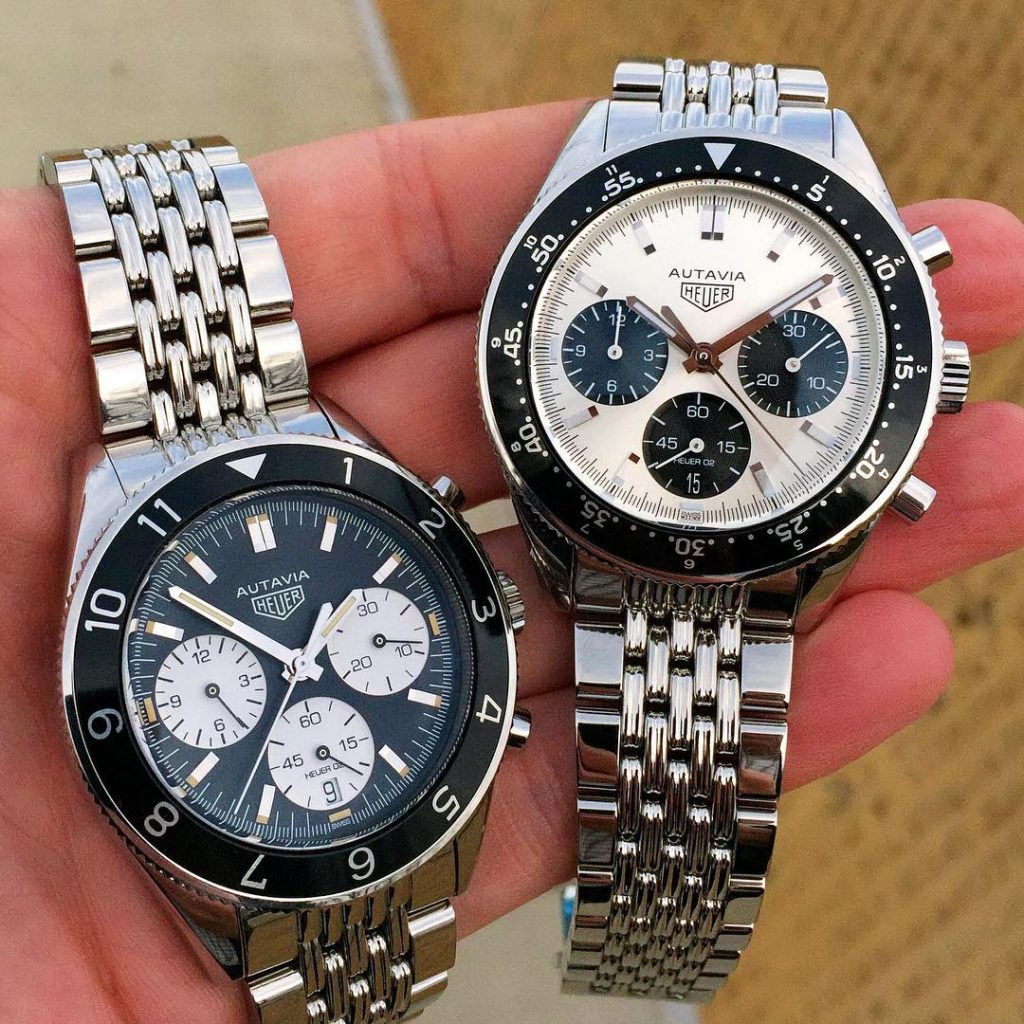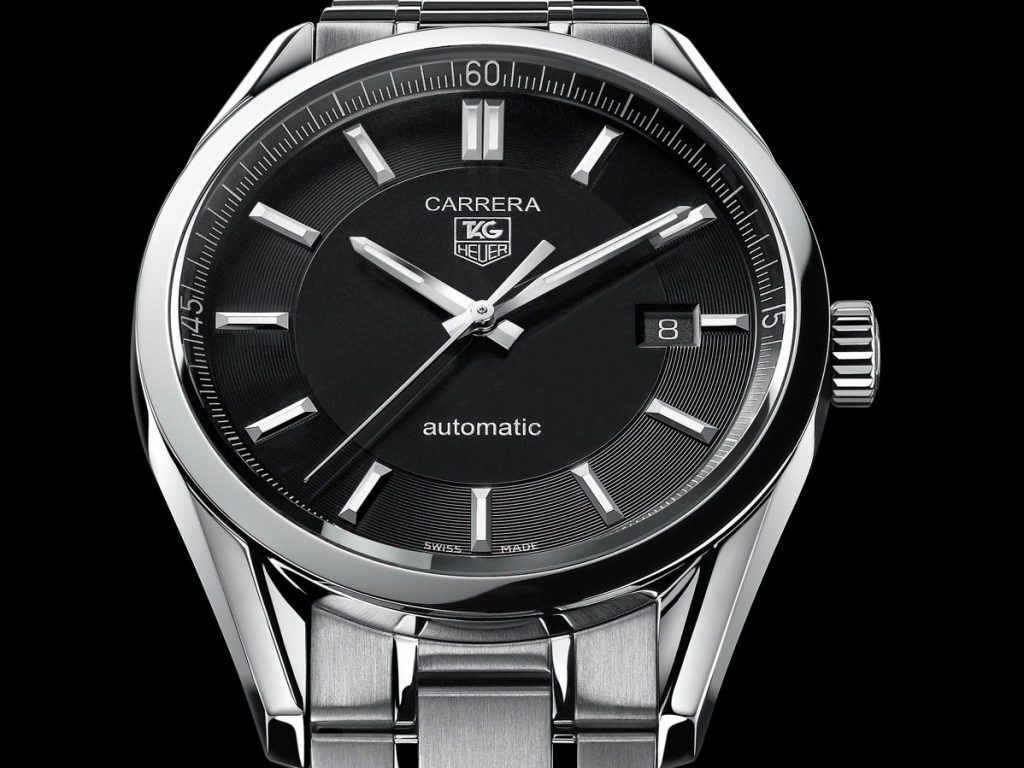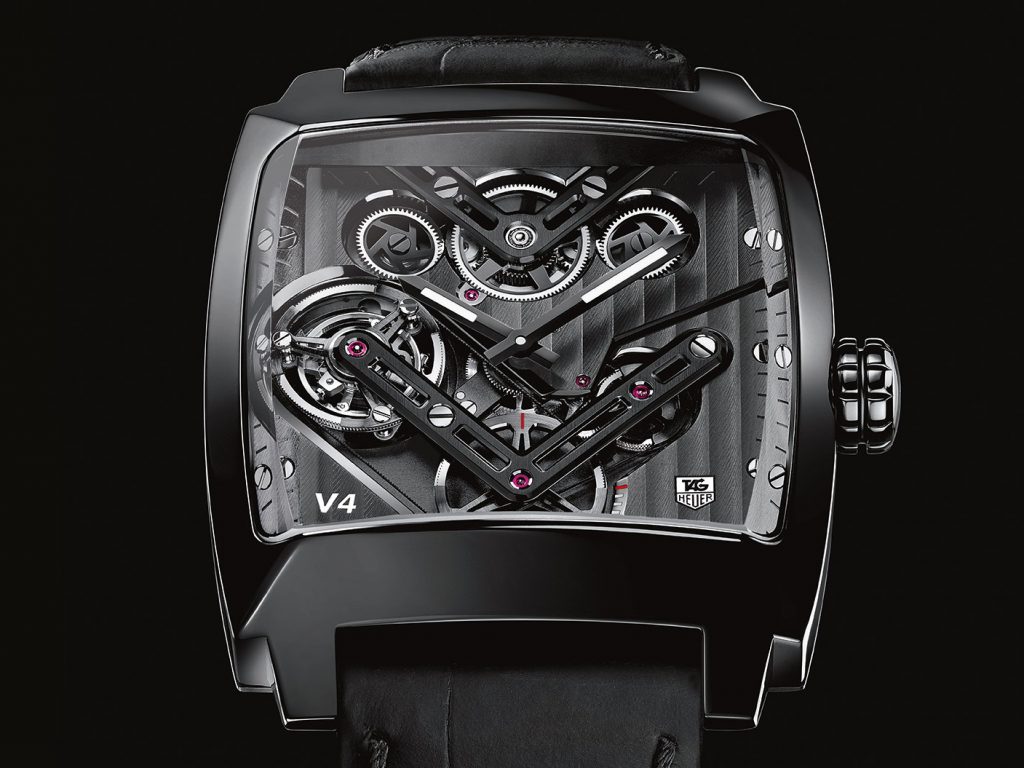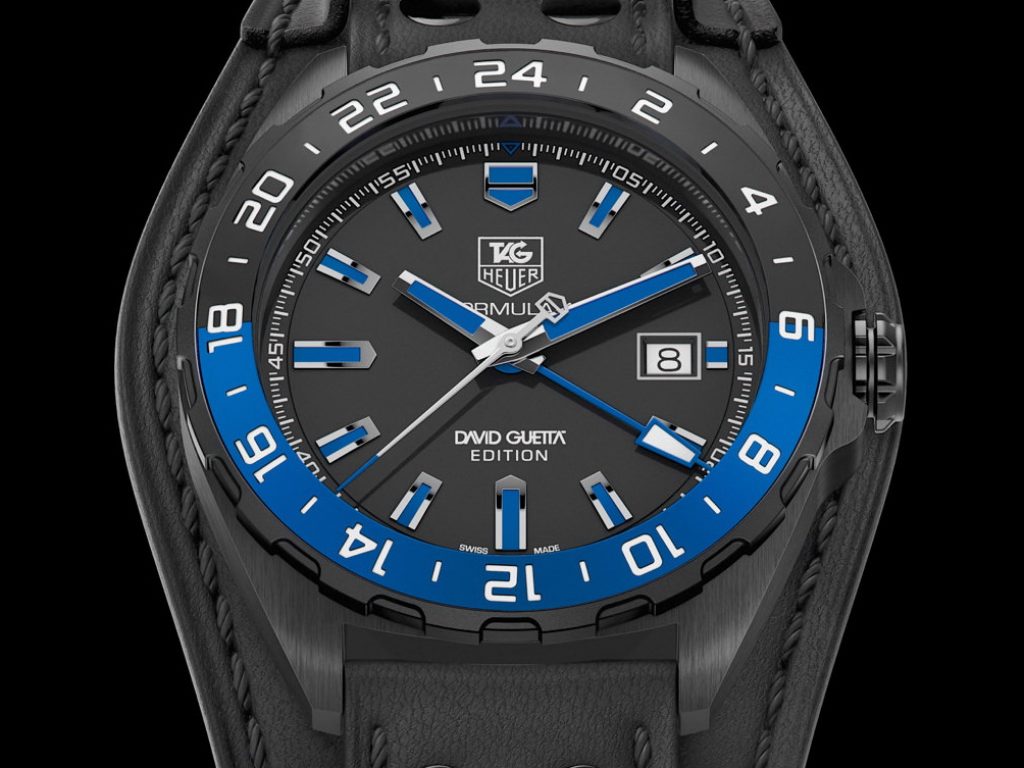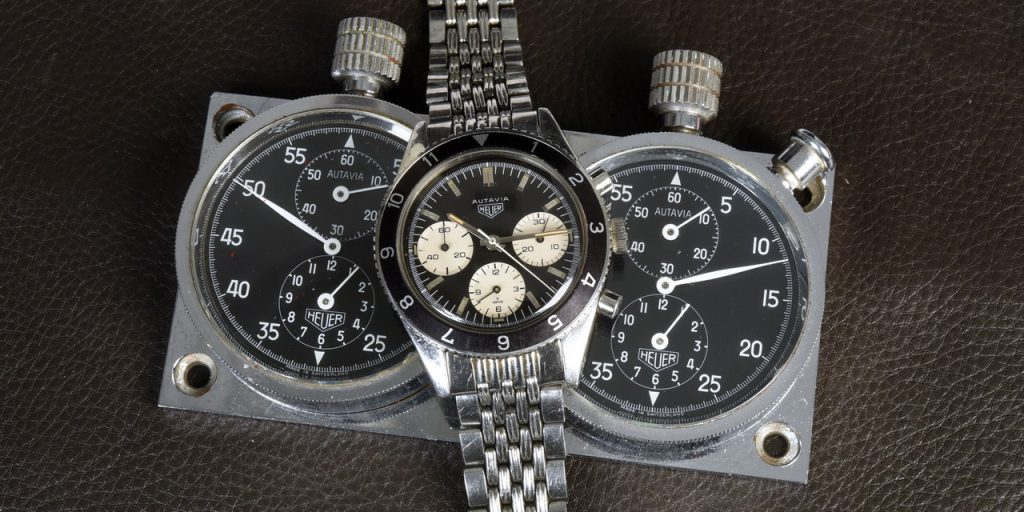Last year, at Baselworld (March 2018), TAG Heuer allowed a “leak” of two Autavia prototypes. These prototypes were different from all the Autavias that Heuer and TAG Heuer have offered, over the period since 1962, in that the two prototypes were not chronographs, but were plain, old-fashioned watches (i.e., no built-in stopwatch, but only hands to tell the time of day). One was a three-hand model (hours, minutes and seconds), powered by TAG Heuer’s Calibre 5 movement, and the other was a GMT model (having a fourth hand to track a second time zone), powered by the Calibre 7 movement.
As we approach Baselworld 2019, it seems likely that TAG Heuer will officially introduce these “watch” versions of the Autavia. To prime the pump for discussion, shown below is a lightly edited version of my posting from the OnTheDash discussion forum, from March 29, 2018.
As I have been thinking about the introduction of the three-handed Autavias in 2019, I consider what happened in 1962, with the introduction of the first Autavia chronographs. From when it was introduced in 1933, the Autavia had been one of Heuer’s dashboard timers, a stopwatch with 12-hour capacity. The name “Autavia” combined the words AUTomotive and AVIAtion, as the timer was designed for motorsports and aviation. So here was a unique name that Heuer used for 19 years, for a specific type of device — a 12-hour dashboard timer.
It must have been relatively simple back in 1962, when Jack Heuer decided that the name “Autavia” would now be used for a wrist chronograph. There was no online community of passionate collectors and there were no discussion forums, Facebook groups, Instagram hashtag or other social media. There were no “influencers” to suggest what the rest of us should think of the new Autavia chronographs (or Heuer’s decision to “re-use” the Autavia name). And so Jack Heuer made the decision, and 57 years later, most would agree that it all worked out pretty well for the company.
If TAG Heuer announces a three-hand Autavia next week at Baselworld 2019, we can expect debates in Facebook groups, pronouncements from the influencers and suggestions from other experts either that this new Autavia is a brilliant extension of the Autavia model line or a disgrace to the Autavia name. My suggestion — let’s see what we think of the watch, as a timepiece on our wrists. Then, five years from now or 57 years from now, we can look back and put the decision to make a three-handed Autavia into some better perspective. But for now, let’s just see whether we like the watches.
With that little addendum, here is how I reacted to the idea of a three-handed Autavia last year, when we first saw the new Autavia prototypes.
Posting from March 29, 2018
Today, we saw and discussed three and four-handed Autavias. That’s right, prototypes of Autavias that are “watches” rather than “chronographs”. How can this be? Every Autavia that Heuer has made since 1962 has been a chronograph?
The following are quick reactions / half-baked thoughts, from someone who knows nothing about branding / marketing / product development, but has a deep commitment to the vintage Autavias.
Let’s Start with the Bottom Line. I am fine with TAG Heuer launching three-hand (non chronograph) Autavias, and believe that the DNA claims / heritage positioning are legitimate. A lower-priced version of the Autavia should fit nicely into the TAG Heuer catalog, for those who like the style and imagery of the Autavia, but are seeking a less expensive entry into this world.
Would I buy it? Maybe. If it’s a great looking watch. Should TAG Heuer offer it? Definitely!!
The Three-Handed Carreras. I like the Carrera Calibre 5 watches. They are simple “three-hand” watches, that take their styling cues from the traditional Carrera chronographs from the 1960s, and TAG Heuer has offered Calibre 5 Carreras in a variety of different looks. I purchased one of these Carreras for our son-in-law to wear on his wedding day and have recommended them to several friends who were buying their first “real watches”. All of them have been happy with their Carreras and become TAG Heuer enthusiasts.
Yes, I realized that historically all the Carreras had been chronographs, and for a moment there seemed to be something missing from the Carrera “watches”. Still, I got over that issue fairly quickly. The Caliber 5 Carreras are good looking watches; they are attractively priced; and the fact that they carry the “Carrera” name is OK with me. In fact, it’s better than OK; it’s a good thing.
The Need for “Heritage” Models. Many vintage enthusiasts worry about TAG Heuer’s commitment to its heritage and the development of its vintage portfolio. Have a look at the “Heritage Collection” on the TAG Heuer website and see whether you can make any sense of it.
This Heriatge section includes exactly 11 models — five Monacos (three of them with three hands); one Monza; three Autavias; and two Carreras. How can it be that a brand with such a rich, distinctive heritage got into the position of offering only 11 “heritage” models? There were over 200 versions of the Autavia and Carrera from 1962 to 1985. How can TAG Heuer now offer only 11 heritage-inspired models? More importantly — how can TAG Heuer build out this line-up of heritage models?
Accessible Luxury. So we ask how TAG Heuer has been leveraging its remarkable vintage portfolio. That’s the question that has been so difficult to answer. Let’s look at the positioning of the TAG Heuer brand, since Jean-Claude Biver became the CEO, in December 2014. We know that TAG Heuer wants to represent “accessible luxury” or maybe it’s “entry level” luxury. It’s a luxury item, but with a relatively low price of admission.
In this line-up of “entry level” watches, the Formula 1 and Aquaracer occupy very natural positions. So too, the Connected Watch (which lives in a derivative of the Carrera case). TAG Heuer offers a nice selection of watches in the $1,500 to $3,000 price range. Above that, in the $3,000 to $5,000 band, we see some Carrera chronographs and the Autavia chronographs, which were introduced in 2017. There are relatively few options above that price point.
Younger Ambassadors for Younger Enthusiasts. We need to keep in mind that TAG Heuer is looking for younger customers, perhaps buying their first luxury watches. Since Jean-Claude Biver took the helm, the “Ambassadors” are no longer the top Hollywood stars or world-famous athletes (like Tiger or Maria), but younger, action-oriented characters. Yes, think of surfers, DJs, models, cyclists, etc. And, yes, the graffiti artist Alec Monopoly. Look at the line-up of TAG Heuer ambassadors, and ask yourself how many ambassadors would the average middle-aged person recognize? Very few. But that’s OK, because TAG Heuer is not focusing on middle-aged watch buyers.
Inevitably, the strategy of selling “entry level” luxury watches to younger enthusiasts requires TAG Heuer to offer good choices at lower price points. If the young buyer wants the 2017 Autavia, with its in-house Heuer 02 movement, but doesn’t want to spent $5,000 to $7,000 on this chronograph, let’s see whether they will be enthusiastic about a three-hand Autavia at a much more affordable price. Let’s price this new Autavia somewhere between the entry-level Formula 1 models and the top-of-the-line Carrera and Autavia chronographs, and see whether new watch enthusiasts will bite.
Repositioning the Heritage Portfolio. So how should TAG Heuer’s “Heritage Portfolio” fit into all this? It seems like the natural position for the heritage-inspired watches is at the top of the TAG Heuer range, say, in the $5,000 to $7,000 band. At this price point, TAG Heuer can produce a high-quality watch, with an in-house movement, with this heritage-inspired model sitting at the top of the TAG Heuer food chain. Yes, let the heritage models with their in-house movements be the “aspirational” models for those who are new to the brand.
And what does the TAG Heuer Heritage Portfolio look like, right now? It looks like cats and dogs, a handful of watches copied onto the heritage page, after originally residing somewhere else. It is impossible to look at this Heritage Collection and see any coherent catalog or strategy. It is sad to look at it as all that is left of Heuer’s glorious catalogs from the 1960s and 1970s. It gets even sadder when we see what other brands have done in the heritage or vintage-inspired category of modern watches (for example, Omega, Tudor and Breitling).
About the Heuer DNA. So can an Autavia have only three-hands (and not be a chronograph)? Yes, of course it can, just like the Carrera can and the Monaco can. There can be fantastic looking watches (with only three hands), inspired by the vintage chronographs (which had twice that number of hands). And if they have the right style and features, they can legitimately claim the DNA of the historic predecessors!!
On the other hand, many of the new TAG Heuer Carreras are stretching when they make the DNA claims. Look at most of the recent high-end Carrera chronographs, with their skeletonized dials, and once you get past the basic geometry of the lugs, there is no real connection to the original Carreras from the 1960s. Yes, the press releases will always talk about DNA and legibility, but this hardly seems credible. Maybe these Carreras are stepping stones to the higher priced Zeniths or Hublots, and maybe TAG Heuer can be successful in selling them, but it’s difficult to see the origins of these new Carreras in the Carreras of the 1960s.
The Place for the Three-Handed Autavia. So how will the three-handed Autavia fit in? It seems to have a natural position, as a step above the Calibre 5 Carreras and Aquaracers (priced between $1,500 and $4,000), while resting a step below the Heuer 02 powered Autavias (priced in the $5,000 to $6,000 range). Perhaps it’s the entry-level / gateway Autavia, and that’s OK with me. Yes, the DNA can be there, even if it’s not a chronograph.
Some have suggested that the new three-hand model should have a different name from Heuer’s historic models. Heuer made some great three-hand dive watches, for example. It does not seem realistic to add a new model name to the TAG Heuer catalog. This catalog can only have a limited number of chapters, and it seems better to build out the third leg of the “Big Three” (Carrera, Monaco and Autavia), than to add a new model name to the catalog.
Why the Uproar? Finally (or almost finally) – I think all the screaming from the vintage collectors about these new three-handed Autavias is telling (and – oddly enough– gratifying). It shows how much we care about the vintage Autavias. Yes, they are special watches, and we guard their heritage with fervor. Why was there no similar outcry when TAG Heuer launched the three-hand Carreras and Monacos? The “offense” was identical, it’s just that the collectors didn’t really care as much, about guarding the sacred position of all these watches.
Four Hands Even Better Than Three? And what about the GMT version / the “Four Hand” Autavia that we saw at Baselworld in 2018? The blue / black bezel looks great to me. The sky is blue during the day and black at night, and so too the bezel. Yes, historically Rolex used the Pepsi colors, and so did the vintage GMT Autavias, but no need to be bound by those choices. The GMT versions of the TAG Heuer Aquaracer and Formula 1 have used this same blue / black approach, and Heuer also blue / black in the 1970s (for example, with the “Siffert” Autavia).
That’s Why They Make Prototypes. One more thing — what we saw today at Baselworld are prototypes, which clearly have some design issues. I see some kinks to be worked out and am optimistic that the folks at TAG Heuer will improve on these designs, before the watches actually go into production. If nothing else, we have put the TAG Heuer designers on notice that when they mess with our beloved Autavia, they had better get it right!
And to all a good night. Yes, we saw three-handed Autavias today (March 28, 2018), and I expect that the sun will still rise tomorrow morning (March 29, 2018) . . . in the east!! If it doesn’t, we’ll know that TAG Heuer has, in fact, offended the watch gods!
